

Commentary Select
Commentary Select




God's Word for You (GWFY) — Micah
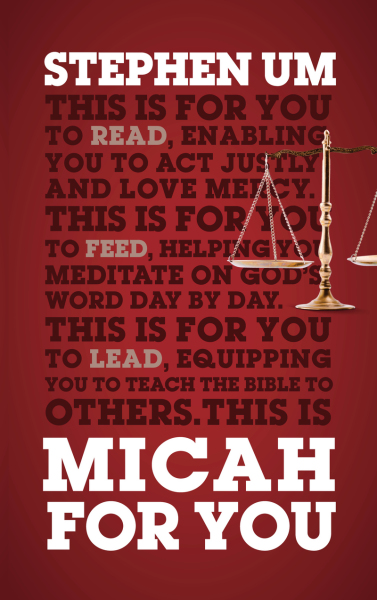
God's Word for You (GWFY) — Micah
"Micah is a passionate plea for justice and mercy, and Stephen Um Shows how it speaks to our broken generation. A very helpful commentary from an expert Bible teacher." - D.A. Carson
Join Dr. Stephen Um as he opens up Micah, helping you get to grips with its meaning and showing how it transforms our hearts and lives today.
We live in a world that craves justice. But what transforms us to truly seek justice, even at cost to ourselves? And what enables us to do so in a way that also offers mercy?
Stephen Um opens up the book of Micah, showing how God’s call to his people then is God’s call to his people now—a call to so enjoy the gospel that we are freed to seek true justice and offer real mercy. This minor prophet is a voice for our times.
This Expository Guide takes you verse by verse through the text in an accessible and applied way. It is less academic than a traditional commentary and can be read cover-to-cover, used in personal devotions, used to lead small group studies, or used for sermon preparation.
Written for people of every age and stage, from enquirers to new believers to pastors and teachers, this flexible resource is for you to:
- READ: As a guide to these gripping events, helping you to see Christ and marvel at God's power, plans and love.
- FEED: As a daily devotional to help you grow in Christ as you read and meditate on this portion of God's word.
- LEAD: As notes to aid you in explaining, illustrating and applying this book as you preach or lead a Bible study.
Whoever you are, and however you use it, this is...Micah for You.
Review
Micah for You is a very helpful lay commentary written by an experienced and expert Bible teacher. Stephen Um takes you through the argument of this reforming prophet, not only making sense of the flow of the book but expertly unpacking the nature of sin and idolatry, the threat of judgment, and the need for hope. Micah is well known for his passionate plea for justice and integrity, and through Dr. Um's exposition Micah, though long dead, still speaks to our broken generation. Particularly helpful are the ways in which Dr. Um draws carefully thought-through connections between this prophet in ancient Israel and the Lord Jesus Christ and his gospel. — D.A. Carson, Research Professor of New Testament, Trinity Evangelical Divinity School, Illinois; President, The Gospel CoalitionStephen Um (PhD, University of St. Andrews) is the Senior Minister of Citylife Church in Boston, Massachusetts. He also teaches New Testament at Gordon-Conwell Theological Seminary and serves as Associate Training Director with Redeemer City to City. For the past 18 years, Stephen and his wife, Kathleen, have been involved in several Presbyterian churches throughout the Northeastern part of the country. He is the author of Why Cities Matter (Crossway). Stephen also serves as a Council member with The Gospel Coalition.
God's Word for You (GWFY) — Psalms

God's Word for You (GWFY) — Psalms
Christopher Ash shows us how to read and apply the book of Psalms. He takes us through 15 pairs of psalms that represent various ‘types’—including some that are very familiar and some that are often ignored.
He helps us to see how they are fulfilled by Jesus and therefore point to Jesus first and foremost, transforming how we read them, enjoy them and sing them.
Christopher Ash comments that this understanding of the Psalms "can shape the dynamics of our Christian lives in ways that neither a dry and arid intellectualism nor a rootless emotionalism can do. The Psalms can make us Christians with deep feelings, deep emotions, deep thoughts, and deep desires."
You can read through this book as a normal book...work through it as part of your daily Bible-reading routine using the questions for reflection at the end of each chapter...or use it to help you teach this book of the Bible, whether in small groups or from the pulpit.
Written for people of every age and stage, from enquirers to new believers to pastors and teachers, this flexible resource is for you to:
- READ: As a guide to these gripping events, helping you to see Christ and marvel at God's power, plans and love.
- FEED: As a daily devotional to help you grow in Christ as you read and meditate on this portion of God's word.
- LEAD: As notes to aid you in explaining, illustrating and applying this book as you preach or lead a Bible study.
Whoever you are, and however you use it, this is...God's Word for You.
Christopher Ash has been a pastor, and is now an author and writer-in-residence at Tyndale House, Cambridge. He was Director of the Proclamation Trust’s Cornhill Training Course from 2004-2015. He is married to Carolyn and they have four children and seven grandchildren.
God's Word for You (GWFY) — Revelation

God's Word for You (GWFY) — Revelation
"Many find Revlation intimidating or just plain confusing. But there's no need to be scared, and every reason to be excited, as it moves our imagination and helps us see the world from heaven's perspective."
Join Tim Chester as he opens up the book of Revelation, helping you get to grips with its meaning and showing how it transforms our hearts and lives today.
Many Christians are confused by the book of Revelation. It moves from strange and disturbing images to warm and practical encouragement; from the fires of Hell to wonderful pictures of a glorious eternity.
And yet the message of the final book of the Bible is both clear and simple. Despite everything that is going wrong with our world, God remains in control. And when we see history, our present, and our future from heaven's perspective, it will encourage us to trust God and remain faithful to the end.
This accessible, absorbing expository guide opens up this book for new and mature Christians alike. It is more applied than a typical commentary, making it a great resource for personal devotion, as well as useful for leading small group studies or sermon preparation.
You can read through this book as a normal book...work through it as part of your daily Bible-reading routine using the questions for reflection at the end of each chapter...or use it to help you teach this book of the Bible, whether in small groups or from the pulpit.
Written for people of every age and stage, from enquirers to new believers to pastors and teachers, this flexible resource is for you to:
- READ: As a guide to these gripping events, helping you to see Christ and marvel at God's power, plans and love.
- FEED: As a daily devotional to help you grow in Christ as you read and meditate on this portion of God's word.
- LEAD: As notes to aid you in explaining, illustrating and applying this book as you preach or lead a Bible study.
Whoever you are, and however you use it, this is...Revelation for You.
Tim Chester is a pastor at Grace Church, Boroughbridge, UK; a faculty member of Crosslands Training; and is the author of over 30 books. He has a PhD in theology and was previously Research and Policy Director for Tearfund UK. He has been an adjunct lecturer in missiology and reformed spirituality. Tim is married to Helen and has two daughters.
God's Word for You (GWFY) — Romans Volume 1

God's Word for You (GWFY) — Romans Volume 1
Combining a close attention to the detail of the text with Timothy Keller's trademark gift for clear explanation and compelling insights, this resource will both engage your mind and stir your heart.
Written for people of every age and stage, from new believers to pastors and teachers, this flexible resource is for you to:
- READ: As a guide to this wonderful letter, helping you appreciate the great gift of righteousness with God.
- FEED: As a daily devotional to help you grow in Christ as you read and meditate on this portion of God’s word.
- LEAD: As notes to aid you in explaining, illustrating and applying Romans 1–7 as you preach or lead a Bible study.
God's Word for You (GWFY) — Romans Volume 2

God's Word for You (GWFY) — Romans Volume 2
Join Dr Timothy Keller as he opens up the second half of the book of Romans, beginning in chapter 8, helping you to get to grips with its meaning and showing how it transforms our hearts and lives today.
Combining a close attention to the detail of the text with Timothy Keller's trademark gift for clear explanation and compelling insights, this resource will both engage your mind and stir your heart.
Written for people of every age and stage, from new believers to pastors and teachers, this flexible resource is for you to:
- READ: As a guide to this wonderful letter, helping you appreciate the great gift of righteousness with God.
- FEED: As a daily devotional to help you grow in Christ as you read and meditate on this portion of God’s word.
- LEAD: As notes to aid you in explaining, illustrating and applying Romans 8–16 as you preach or lead a Bible study.
God's Word for You (GWFY) — Ruth

God's Word for You (GWFY) — Ruth
"Ruth is one of the best short stories ever written. But this is not just about a woman finding a husband, or a widow a family. It is about the royal line that leads to Jesus."
The book of Ruth is a love story. Like all love stories it has twists and turns, tension and resolution, and a happy ending.
But it's far more than that because it reveals to us a God who is deeply committed to caring for his people. In Boaz, God provides Ruth with a loving husband to free and provide for her, pointing us to the Bible's grand story of redemption and David’s greatest son, Jesus.
Tony Merida's compelling story-telling and Christ-centered insights make this both an accessible and absorbing expository guide to the book of Ruth. It can be used for personal devotions, or for leading small-group studies, or for sermon preparation.
You can read through this book as a normal book...work through it as part of your daily Bible-reading routine using the questions for reflection at the end of each chapter...or use it to help you teach this book of the Bible, whether in small groups or from the pulpit.
Written for people of every age and stage, from enquirers to new believers to pastors and teachers, this flexible resource is for you to:
- READ: As a guide to these gripping events, helping you to see Christ and marvel at God's power, plans and love.
- FEED: As a daily devotional to help you grow in Christ as you read and meditate on this portion of God's word.
- LEAD: As notes to aid you in explaining, illustrating and applying this book as you preach or lead a Bible study.
Whoever you are, and however you use it, this is...God's Word for You.
Tony Merida is Pastor for Preaching and Vision of Imago Dei Church, Raleigh, NC; Content Director for Acts 29; and a Council member of the Gospel Coalition. He is the author of a nyumber of books, including The Christ-Centered Expositor and Ordinary. He and his wife, Imberlyh, have five adopted children.
God's Word for You (GWFY) — Titus

God's Word for You (GWFY) — Titus
The overriding passion of believers in the early church was to keep the gospel central for life, growth, and mission. Reading Titus in our time will inspire and equip us to make sure our lives and churches do the same."
Join Dr. Tim Chester as he opens up the book of Titus, helping you get to grips with this short, powerful letter, showing how it transforms our hearts and lives today.
Tim Chester's renowned gifts for making the complex clear, the truth applied and the gospel shine brightly mean this book will take you to the pages of the Bible to engage your mind and stir your heart.
You can read through this book as a normal book...work through it as part of your daily Bible-reading routine using the questions for reflection at the end of each chapter...or use it to help you teach this book of the Bible, whether in small groups or from the pulpit.
Written for people of every age and stage, from enquirers to new believers to pastors and teachers, this flexible resource is for you to:
- READ: As a guide to these gripping events, helping you to see Christ and marvel at God's power, plans and love.
- FEED: As a daily devotional to help you grow in Christ as you read and meditate on this portion of God's word.
- LEAD: As notes to aid you in explaining, illustrating and applying this book as you preach or lead a Bible study.
Whoever you are, and however you use it, this is...Titus for You.
Watch the Titus for You Trailer:
Tim Chester is a pastor at Grace Church, Boroughbridge, UK; a faculty member of Crosslands Training; and is the author of over 30 books. He has a PhD in theology and was previously Research and Policy Director for Tearfund UK. He has been an adjunct lecturer in missiology and reformed spirituality. Tim is married to Helen and has two daughters.
God's Word for You: Exodus

God's Word for You: Exodus
"The book of Exodus is key to understanding Jesus. It is an exciting story, a historical story and - as it points us to and inspires us to worship Jesus, it is our story."
Join Tim Chester as he opens up the book of Exodus, helping you get to grips with its meaning and showing how it transforms our hearts and lives today. This foundational Bible book foreshadows Christ, points to the new creation, and calls us to radical discipleship.
Without Exodus, we have an impoverished understanding of the nature of God, the achievement of the cross, the triumph of the resurrection and the identity of God's people.
With his trademark Christ-centered clarity, Tim Chester walks readers through Exodus, making its great themes thrillingly clear to those new to the book, and unearthing wonderful new surprises for those familiar with it.
You can read through this book as a normal book...work through it as part of your daily Bible-reading routine using the questions for reflection at the end of each chapter...or use it to help you teach this book of the Bible, whether in small groups or from the pulpit.
Written for people of every age and stage, from enquirers to new believers to pastors and teachers, this flexible resource is for you to:
- READ: As a guide to these gripping events, helping you to see Christ and marvel at God's power, plans and love.
- FEED: As a daily devotional to help you grow in Christ as you read and meditate on this portion of God's word.
- LEAD: As notes to aid you in explaining, illustrating and applying this book as you preach or lead a Bible study.
Whoever you are, and however you use it, this is...Exodus for You.
Watch the Exodus for You Trailer:
Tim Chester is a pastor at Grace Church, Boroughbridge, UK; a faculty member of Crosslands Training; and is the author of over 30 books. He has a PhD in theology and was previously Research and Policy Director for Tearfund UK. He has been an adjunct lecturer in missiology and reformed spirituality. Tim is married to Helen and has two daughters.
God's Word for You: Nehemiah

God's Word for You: Nehemiah
The book of Nehemiah chronicles a key moment in the history of God's people: the rebuilding of the walls of Jerusalem after the return from exile.
Understanding this book doesn't just mean knowing about a rebuilt wall. Nehemiah helps us think through any type of rebuilding we might do for God—from our homes and families to our local church, our communities and our world. It teaches us, ultimately, about Jesus and his mission.
A pastor with decades of experience in cities, Dr. Eric Mason unpacks this rich book verse by verse. He explains the context, gives plenty of application for our lives today, and shows us what it looks like to get involved in God's work to build his kingdom.
You can read through this book as a normal book...work through it as part of your daily Bible-reading routine using the questions for reflection at the end of each chapter...or use it to help you teach this book of the Bible, whether in small groups or from the pulpit.
Written for people of every age and stage, from enquirers to new believers to pastors and teachers, this flexible resource is for you to:
- READ: As a guide to these gripping events, helping you to see Christ and marvel at God's power, plans and love.
- FEED: As a daily devotional to help you grow in Christ as you read and meditate on this portion of God's word.
- LEAD: As notes to aid you in explaining, illustrating and applying this book as you preach or lead a Bible study.
Whoever you are, and however you use it, this is...God's Word for You.
Dr. Eric Mason and his wife Yvette have four children. He is the founder and senior pastor of Epiphany Fellowship, Philadelphia, and the founder and president of Thriving. His books include Urban Apologetics, Manhood Restored, Woke Church, and others.
God's Word for You: Proverbs

God's Word for You: Proverbs
Expository Bible-study guide to the book of Proverbs: divin the Proverbs, God offers us wisdom for real life and he shows us Jesus, who was wisdom personified and exemplified.
This accessible, absorbing expository guide to Proverbs by Kathleen Nielson brings these ancient sayings to life, helping ordinary Christians to see what it can look like to enjoy living in line with God's wisdom in the great multitude of everyday situations and decisions we face.
This book gives an expository rather than topical treatment to the book of Proverbs, so it can be read as originally intended. It also has more application than a typical commentary, making it a great resource for personal devotions, as well as useful for leading small-group studies or sermon preparation.
You can read through this book as a normal book...work through it as part of your daily Bible-reading routine using the questions for reflection at the end of each chapter...or use it to help you teach this book of the Bible, whether in small groups or from the pulpit.
Written for people of every age and stage, from enquirers to new believers to pastors and teachers, this flexible resource is for you to:
- READ: As a guide to these gripping events, helping you to see Christ and marvel at God's power, plans and love.
- FEED: As a daily devotional to help you grow in Christ as you read and meditate on this portion of God's word.
- LEAD: As notes to aid you in explaining, illustrating and applying this book as you preach or lead a Bible study.
Whoever you are, and however you use it, this is...God's Word for You.
Kathleen Nielson is a renowned conference speaker internationally, and served as Director of Women's Initiatives at The Gospel Coalition. Kathleen is the author of numerous Bible studies and books. She is married to Niel and they have three sons, three daughters-in-law, and seven granddaughters.
Habakkuk, Zephaniah, Haggai, Zechariah, Malachi (Preacher's Outline & Sermon Bible Series)

Habakkuk, Zephaniah, Haggai, Zechariah, Malachi (Preacher's Outline & Sermon Bible Series)
The Preacher’s Outline & Sermon Bible® (POSB) is a practical and comprehensive commentary set that gives the pastor or teacher everything they need to preach or teach God’s Word. Covering every book of the Bible, POSB is the perfect resource for expository or topical teaching.
With over a million copies sold in print, POSB is unlike any other commentary you will encounter. Each volume gives you detailed, verse-by-verse exposition for every Bible passage. Along with the biblical commentary, POSB includes extensive outlines with sub-points, thoughts on practical application, deeper studies on key biblical topics and themes, and full cross references.
You will quickly see the added value and ease of use that comes with having this commentary in your Olive Tree library. The Olive Tree edition separates the outlines and commentary to make POSB even easier to use. Instead of scrolling back and forth (or flipping pages), you can see the commentary and outlines side-by-side as you study or prepare your sermon. POSB is also fully functional with the Resource Guide and is configured to help you get to the information you need quickly. You can both drill down to the verse you want to study and easily find all the introductory material on each book of the Bible.
The Preacher’s Outline and Sermon Bible makes it easy to create life-changing sermons and lessons. Everything you need to understand any passage of the Bible is right at your fingertips. And this resource is not just for preachers and teachers; it’s perfect for any Christian who wants to know God’s Word better.
POSB features include:
- Detailed outlines for every book of the Bible
- Well researched and easy to read commentary
- Practical application for godly living
- Deeper studies to dive into key topics and themes
- Full text cross references (no need to look them up)
Hebrews & James (Preacher's Outline & Sermon Bible Series)

Hebrews & James (Preacher's Outline & Sermon Bible Series)
The Preacher’s Outline & Sermon Bible® (POSB) is a practical and comprehensive commentary set that gives the pastor or teacher everything they need to preach or teach God’s Word. Covering every book of the Bible, POSB is the perfect resource for expository or topical teaching.
With over a million copies sold in print, POSB is unlike any other commentary you will encounter. Each volume gives you detailed, verse-by-verse exposition for every Bible passage. Along with the biblical commentary, POSB includes extensive outlines with sub-points, thoughts on practical application, deeper studies on key biblical topics and themes, and full cross references.
You will quickly see the added value and ease of use that comes with having this commentary in your Olive Tree library. The Olive Tree edition separates the outlines and commentary to make POSB even easier to use. Instead of scrolling back and forth (or flipping pages), you can see the commentary and outlines side-by-side as you study or prepare your sermon. POSB is also fully functional with the Resource Guide and is configured to help you get to the information you need quickly. You can both drill down to the verse you want to study and easily find all the introductory material on each book of the Bible.
The Preacher’s Outline and Sermon Bible makes it easy to create life-changing sermons and lessons. Everything you need to understand any passage of the Bible is right at your fingertips. And this resource is not just for preachers and teachers; it’s perfect for any Christian who wants to know God’s Word better.
POSB features include:
- Detailed outlines for every book of the Bible
- Well researched and easy to read commentary
- Practical application for godly living
- Deeper studies to dive into key topics and themes
- Full text cross references (no need to look them up)
Hebrews: Ancient Christian Commentary on Scripture (ACCS)
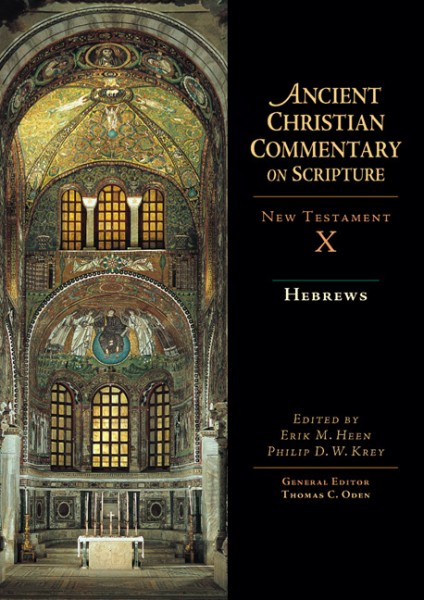
Hebrews: Ancient Christian Commentary on Scripture (ACCS)
The Ancient Christian Commentary on Scripture does what very few of today's students of the Bible could do for themselves. With the aid of computer technology, the vast array of writings from the church fathers—including much that is available only in the ancient languages—have been combed for their comment on Scripture. From these results, scholars with a deep knowledge of the fathers and a heart for the church have hand-selected material for each volume, shaping, annotating and introducing it to today's readers. Each portion of commentary has been chosen for its salient insight, its rhetorical power and its faithful representation of the consensual exegesis of the early church.
The Ancient Christian Commentary on Scripture is an ecumenical project, promoting a vital link of communication between the varied Christian traditions of today and their common ancient ancestors in the faith. On this shared ground, we listen as leading pastoral theologians of seven centuries gather around the text of Scripture and offer their best theological, spiritual and pastoral insights.
Today the historical-critical method of interpretation has nearly exhausted its claim on the biblical text and on the church. In its wake there is a widespread yearning among Christian individuals and communities for the wholesome, the deep and the enduring. The Ancient Christian Commentary on Scripture does not seek to replace those excellent commentaries that have been produced in the twentieth century. Rather, it supplements them, framing them with interpretive voices that have long sustained the church and only recently have fallen silent. It invites us to listen with appreciative ears and sympathetic minds as our ancient ancestors in the faith describe and interpret the scriptural vistas as they see them.
The Ancient Christian Commentary on Scripture is a postcritical revival of the early commentary tradition known as the glossa ordinaria, a text artfully elaborated with ancient and authoritative reflections and insights. An uncommon companion for theological interpretation, spiritual reading, and wholesome teaching and preaching.
About the Hebrews volume:
Distinctive in form, content and style, the epistle to the Hebrews offers a profound high Christology and makes an awe-inspiring contribution to our understanding of Jesus as our High Priest. The earliest extant commentary on the letter comes to us in thirty-four homilies from John Chrysostom. These homilies serve to anchor the excerpts chosen by the editors of this volume because of their unique place in the history of interpretation. In addition to being the first comprehensive commentary on the letter, they deeply influenced subsequent interpretation in both the East and the West, and their rhetorical eloquence has long been acknowledged.
As in other Ancient Christian Commentary volumes, the excerpts chosen range widely over geography and time from Justin Martyr and Clement of Rome in the late first and early second century to The Venerable Bede, Isaac of Nineveh, Photius and John of Damascus in the eighth and ninth centuries. The Alexandrian tradition is well represented in Clement of Alexandria, Origen, Athanasius, Didymus and Cyril of Alexandria, while the Antiochene tradition is represented in Ephrem the Syrian, Theodore of Mopsuestia, Severian of Gabala and Theodoret of Cyr. Italy and North Africa in the West are represented by Ambrose, Cassiodorus and Augustine, while Constantinople, Asia Minor and Jerusalem in the East are represented by the Great Cappadocians--Basil the Great, Gregory of Nazianzus and Gregory of Nyssa--Eusebius, Cyril of Jerusalem and Jerome.
Edited by Erik M. Heen and Philip D. W. Krey, this volume offers a rich treasure of ancient wisdom from Hebrews for the enrichment of the church today.
Hebrews: Bible Speaks Today (BST)
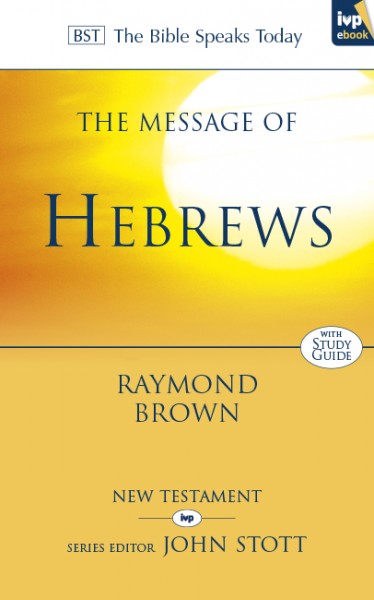
Hebrews: Bible Speaks Today (BST)
Times were hard for the first readers of the letter to the Hebrews. Many had been exposed to fierce persecution. They had been assaulted, their homes had been plundered, and some had been cast into prison.
To such people this letter came as an encouragement. The writer of the letter turns their eyes to Christ, and shows how he fulfils the hope expressed in the Old Testament sacrifices. He calls his readers to a steadfast faith that will take them through the hard times they now face.
Such encouragement and challenge is never without relevance to Christians. Raymond Brown demonstrates this clearly in his passage-by-passage exposition.
About the Bible Speaks Today (BST) Series:
Edited by J.A. Motyer and the late John R. W. Stott, the Bible Speaks Today commentaries are characterized by what Stott called a "threefold ideal . . . to expound the biblical text with accuracy, to relate it to contemporary life and to be readable." As such, each contributor in this series is both a noted scholar and a working pastor.
The BST series, now complete, covers all sixty-six books of the bible (Old and New Testaments) in fifty-five volumes. If you preach or teach from Scripture, the Bible Speaks Today series will help you apply the timeless biblical message to the everyday experiences of your listeners. And if you study the Bible on your own, these volumes will be a helpful resource focusing on the significance of God's Word for your own life and work.
Hebrews: New International Greek Testament Commentary Series (NIGTC)
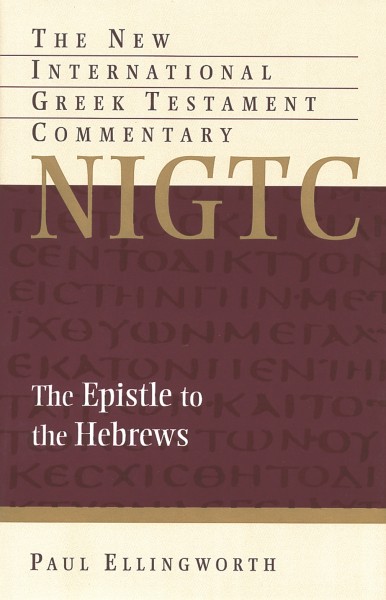
Hebrews: New International Greek Testament Commentary Series (NIGTC)
Paul Ellingworth's study of the UBS Greek New Testament text brings to light the beauty of the style of the writer of Hebrews, casting away any ambiguities in the Greek prose with a strong exegetical commentary on the text. His understanding of the Old Testament and non-biblical texts in the epistle is impressive, and his theologically-sensitive style appeals to all scholars of the Greek text on Hebrews.
Awards and Recognition
Christianity Today, Number 3 Critics Choice for Commentaries (1994)
Reviews
Catholic Biblical Quarterly
"The meticulousity, fairness, and good judgment with which philology, textual criticism, relevant biblical and nonbiblical texts, and secondary literature are brought to bear on Hebrews is impressive. This work joins the list of the other excellent commentaries on Hebrews which have been published in recent years, but it carves a niche all its own."
Hermeneia: 1 Chronicles (HERM)
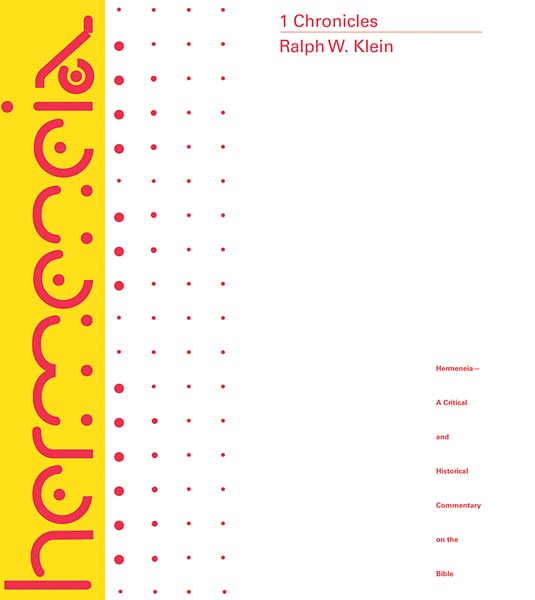
Hermeneia: 1 Chronicles (HERM)
This commentary takes full advantage of recent advances in the textual history of Samuel and Kings, demonstrating in many cases that the differences often ascribed to the Chronicler came in fact from the divergent copy of the canonical books he was rewriting. Klein brings to lively expression the unique theological voice of the Chronicler and demonstrates there have been far fewer secondary additions to the text than is normally assumed.
Hermeneia: 1 Corinthians (HERM)
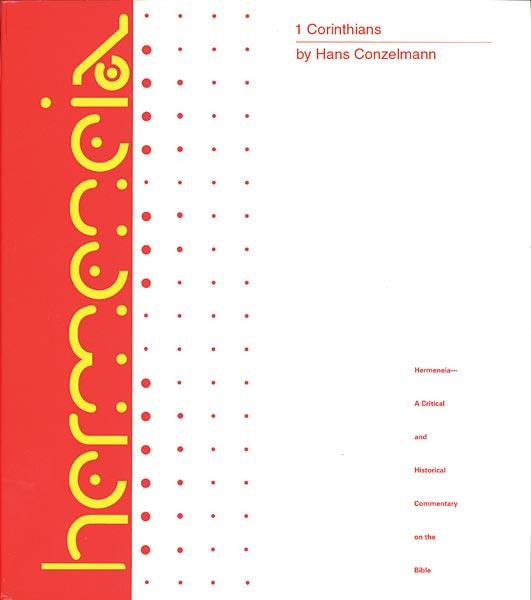
Hermeneia: 1 Corinthians (HERM)
This commentary on 1 Corinthians will bring to serious students, as well as pastors and ministers, the critical guide needed for their biblical work.
Hermeneia: 1 Peter (HERM)

Hermeneia: 1 Peter (HERM)
This commentary, the fruit of years of research, is a gold-mine for clergy and an indispensable resource for students and scholars. Achtemeier brings to this text his characteristic mastery of scholarship, theological insight and balanced judgment.
Hermeneia: 2 Chronicles (HERM)
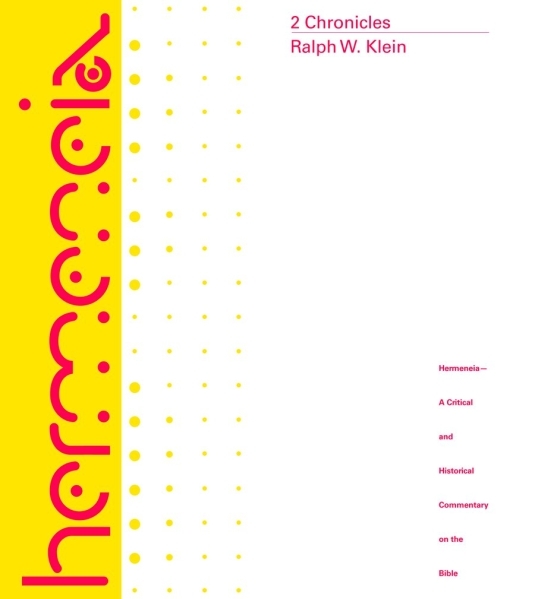
Hermeneia: 2 Chronicles (HERM)
This volume completes Ralph Klein's magisterial commentary on 1 and 2 Chronicles. Klein incorporates the breakthroughs of the last half-century of research. He shows that the Chronicler used a text of Kings significantly different from the Masoretic Text; argues that the Chronicler's departures from the historical picture of Kings result from a distinctive theological agenda for fourth-century Judah; and explores the contours of that message—what it meant to live faithfully, to participate in temple and worship life, in the absence of political independence.
Hermeneia: 2 Corinthians 8 & 9 (HERM)
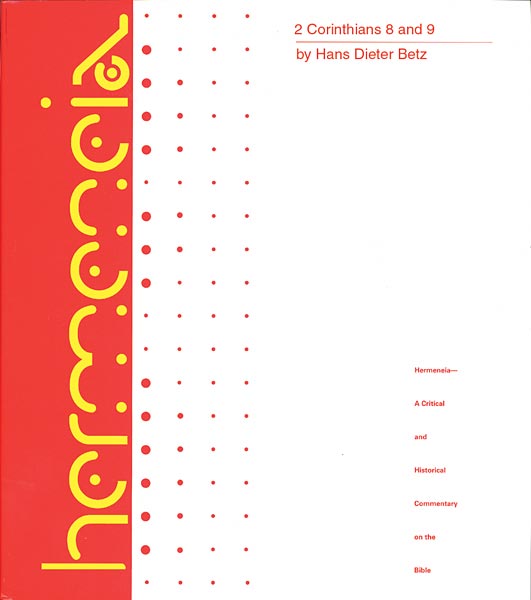
Hermeneia: 2 Corinthians 8 & 9 (HERM)
The series [Hermenia] is designed to be critical and historical commentary to the Bible without arbitrary limits in size or scope. It will utilize the full range of philological and historical tools, including textual criticism (often slighted in modern commentaries), the methods of the history of tradition (including genre and prosodic analysis), and the history of religion.
Hermenia is designed for the serious student of the Bible. It will make full use of ancient Semitic and classical languages; at the same time, English translations of all comparative materials – Greek, Latin, Canaanite, or Akkadian – will be supplied alongside the citation of the source in its original language. Insofar as possible, the aim is to provide the student or scholar with full critical discussion of each problem of interpretation and with the primary data upon which the discussion is based.
Hermeneia: 2 Maccabees (HERM)
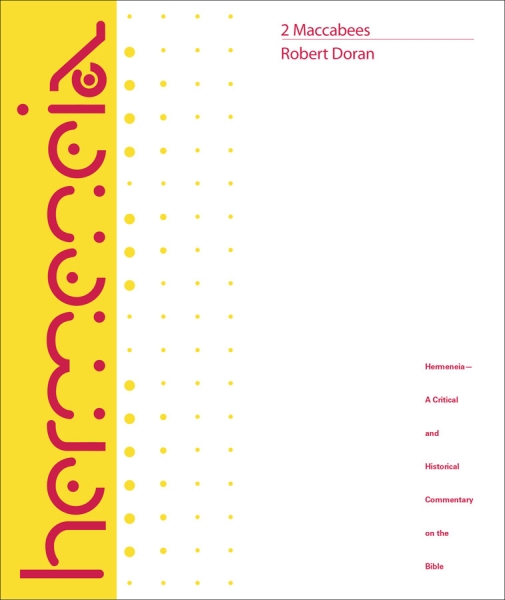
Hermeneia: 2 Maccabees (HERM)
The second-century B.C.E. Maccabean revolt against Seleucid oppression was a watershed event in early Jewish history and Second Maccabees is an important testimony to the revolt and its aftermath. Robert Doran's commentary on 2 Maccabees explores the interplay between history and historiography in the document. Providing detailed philological analysis of the elegant Greek of the text, Doran carefully sifts the evidence for the historicity of the events recounted, while giving full attention to the literary and rhetorical qualities that mark this dramatic narrative.
Hermeneia: Acts (HERM)

Hermeneia: Acts (HERM)
The Acts of the Apostles joins the Gospel of Luke with the ministry of Paul. Renowned New Testament scholar Richard I. Pervo shows how this masterful storyteller worked his magic, drawing on first-century literary techniques of narration and characterization. Luke's literary skills did not prevent scribes from re-writing his masterwork, however, the textual tradition of Acts is among the most intriguing of the documents of the New Testament, and is a focus here.
Elegantly written, Pervo's commentary provides a compelling interpretation of Acts in the context of Hellenistic literature and the emerging Christian movement, Readers will rediscover the "profit with delight" that was the ideal of ancient story-tellers.
Hermeneia: Acts of the Apostles (HERM)
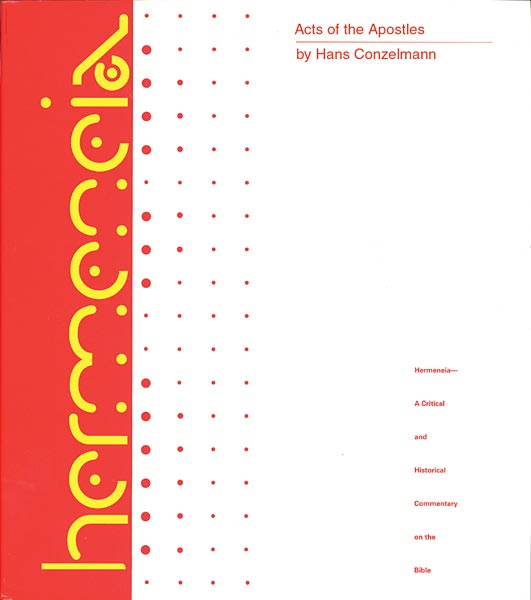
Hermeneia: Acts of the Apostles (HERM)
Filled with compact, almost aphoristic observations about the text, its background, and its theology. Its insight should sustain its value for a full generation.
Hermeneia: Amos (HERM)
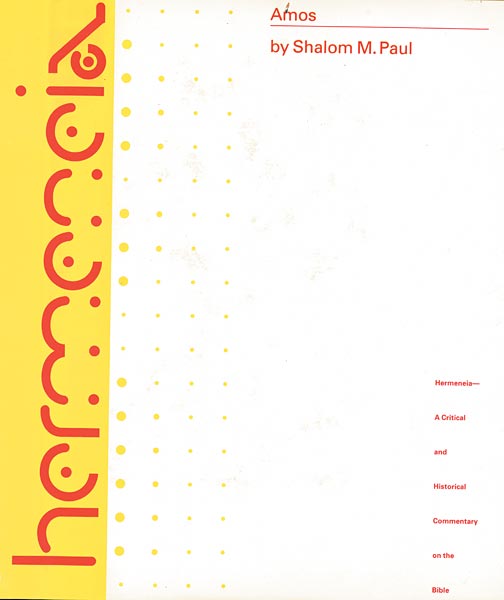
Hermeneia: Amos (HERM)
Makes extensive use of ancient Near Eastern sources, and employs medieval Jewish exegesis along with modern Israeli biblical scholarship.
Hermeneia: Colossians & Philemon (HERM)

Hermeneia: Colossians & Philemon (HERM)
Lohse gives the reader solid interpretation and access to other scholars' efforts.
Hermeneia: Daniel (HERM)
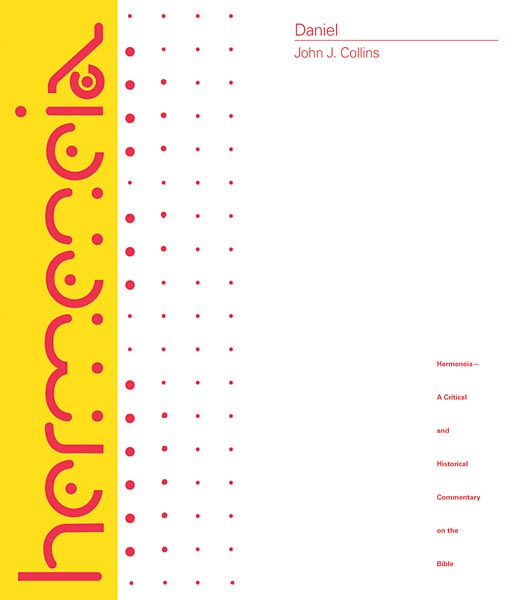
Hermeneia: Daniel (HERM)
The most comprehensive English-language commentary on Daniel in 65 years. Collins situates the Old Testament in its historical context and offers a full explanation of the text, especially its religious imagery.
Hermeneia: Deutero-Isaiah (HERM)

Hermeneia: Deutero-Isaiah (HERM)
Deutero-Isaiah's work, which comprises Isaiah chapters 40–55, has exerted its influence on testimonies of faith in both Jewish and Christian tradition down to the present day.
Baltzer's magnificent commentary places the document in the new context after the Exile. The experience of catastrophe, the need to grapple with new problems, and hope for a peaceful future are linked in Deutero-Isaiah's composition. The work aims to establish accord between adherents of the Jacob/Israel tradition on the one hand and those committed to the Zion/Jerusalem tradition on the other — the background being the tensions between the exiles and the people who had remained on the land.
Along with masterful presentation of the book's themes, Baltzer also develops a creative hypothesis about the work's genre, identifying it as a "liturgical drama" in six acts, which makes it possible to understand the text's function in worship and its significance as a literary text of supreme artistry
Hermeneia: Ezekiel 1-24 (HERM)
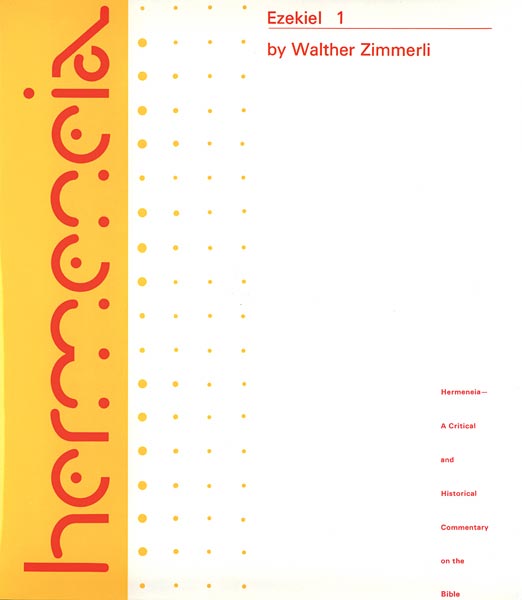
Hermeneia: Ezekiel 1-24 (HERM)
This book will become one of the classic works on Ezekiel. It is so thorough that it will be most useful to the scholar and serious students.
Hermeneia: Ezekiel 25-48 (HERM)
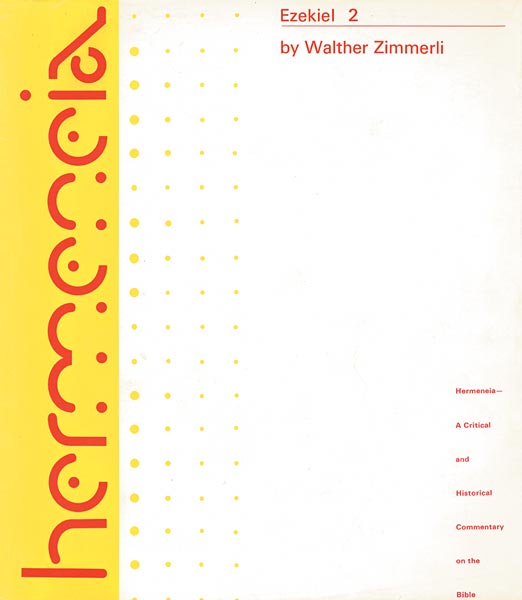
Hermeneia: Ezekiel 25-48 (HERM)
A major achievement ... An essential tool for any serious study of Ezekiel.
Hermeneia: First Isaiah (HERM)
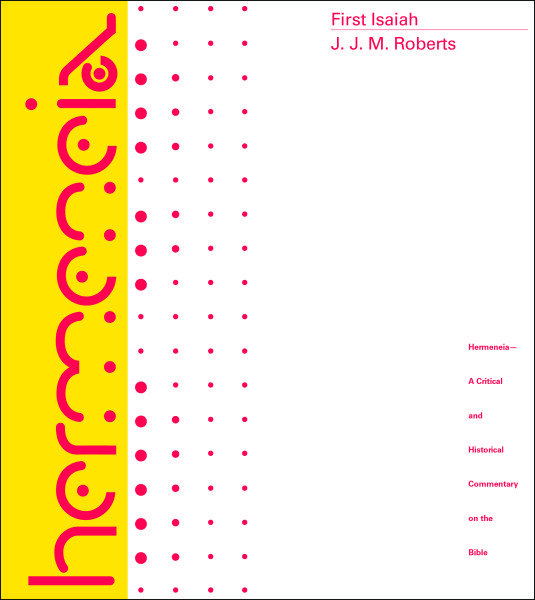
Hermeneia: First Isaiah (HERM)
The eighth-century BCE Isaiah of Jerusalem, the so-called First Isaiah, is one of the most important theological voices in the Bible. J. J. M. Roberts takes a classical historical-critical approach to his interpretation of this material, making good use of his broad comparative knowledge of ancient Near Eastern historical and religious sources.
In light of Isaiah’s very long prophetic ministry of at least thirty-eight years, and perhaps as long as fifty-three years, Roberts also suggests Isaiah often reedited older oracles from early in his ministry to address new, though somewhat analogous situations, albeit with different players, later in his ministry, without erasing telltale signs of the material’s earlier origin.
In many cases, this suggestion provides a better explanation for glaring inconsistencies in an apparently connected text than the common fragmentation of the text that attributes such inconsistencies to later editors who either misunderstood or intentionally altered Isaiah’s message for their own purposes.
Hermeneia is designed for the serious student of the Bible. It makes full use of ancient Semitic and classical languages; at the same time, English translations of all comparative materials—Greek, Latin, Canaanite, or Akkadian—are supplied alongside the citation of the source in its original language. Insofar as possible, the aim is to provide the student or scholar with full critical discussion of each problem of interpretation and with the primary data upon which the discussion is based.
The editors of Hermeneia impose no systematic-theological perspective upon the series (directly, or indirectly by selection of authors). Its authors lay bare the ancient meaning of a biblical work or pericope. In this way the text's human relevance should become transparent, as is always the case in competent historical discourse. However, the series eschews for itself homiletical translation of the Bible.






- Adapt your commentary collection month-to-month based on the book or books you are studying.
- Build your commentary library strategically without hundreds of dollars of upfront investment.
- Never get stuck with commentaries you rarely use - swap them out each month as your needs change.



